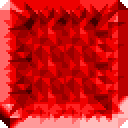Power Gems
When going for large Power Gems, it's best to build them vertically rather than horizontally. If you build a large Power Gem horizontally, you leave less space to discard unwanted gems. So as a rule of thumb, always remember to build Power Gems vertically for efficiency.
Power Gem width
It's generally best to build a Power Gem the width of two or three normal Gems. This is perhaps the most efficient way because if the Power Gem is made any wider, not only is there no guarantee you'll receive the color Gem you need, but you also leave less space to place unwanted Gems. When engaged in a grueling match, it's best to build Power Gems containing less than nine normal Gems. This way, you're not at the mercy of the random Gem drops, and it leaves room to build other Power Gems.
Power Gem size
It's best to build Power Gems that contain a squared number of normal Gems. By building Gems that contains a squared number of normal Gems (4, 9, 16, 25, or the impossible 36), you receive far more points for deleting them than you would for a Power Gem that isn't composed of a squared number. For instance, if you detonate a Power Gem that contains only 15 Gems, you'll be awarded with 39 Counter Gems to attack with. However, if you detonate a Power Gem that consists of 16 Gems, you'll be awarded 50 Counter Gems to attack with. For only one mere Gem, there is an 11 Gem difference.
 = = |
 = = |
It sounds easier than it actually is, but if possible, go for the Power Gem composed of 16 Gems. Take into consideration that there are many circumstances that will affect the number of Counter Gems a Power Gems of any size will allot. The biggest deciding factors are how cluttered your opponent's play field is, how late in the game the Power Gem was detonated, and most importantly, what the handicap settings are when choosing your character.
Building Power Gems
To really become effective, you must always make Power Gems. Below is an example using 12 normal Gems of the same color. The first diagram shows the 12 linked, and not in Power Gem formation. The second diagram illustrates the same Gems, only six have been stacked into a Power Gem, and are linked to three normal Gems on either side of it. Finally, the third example shows all 12 normal Gems stacked into one large Power Gem. It's easy to see how much more effective it is to build Power Gems. Not only will you receive a higher point count, but also a higher number of Counter Gems to attacks with (not to mention a large bonus at the end if you win.) Under ideal circumstances using this example, you'd receive six more Counter Gems by building a small Power Gem rather than just linking 12 Gems, and 18 more Counter Gems by building one huge Power Gem.
|

| ||||
| 1410 Points, |
2010 Points, |
3210 Points, |
|---|
Tips
When you see a pair of normal Gems falling, and you only need one of them to continue building your Power Gem, you should separate them. This way you can continue to build vertically, rather than limiting yourself.
When a Crash Gem and a normal Gem of the same color come down, it's far more effective to place the normal Gem into the Power Gem of the same color you wish to delete. This way, it adds to the Gem count in your Power Gem, giving you more points and possibly more Counter Gems.
| → | 
|
When your Power Gem is three Gems wide, it's best to place pairs of Gems that are the same color vertically in the center of your Power Gem. This leaves room for you to separate a pair of Gems containing the one Gem you need to continue building your Power Gem.
When a falling Gem that you need is attached to a Crash Gem of a different color, stack it vertically on your Power Gem, with the Crash Gem on top. Chances are you'll receive another pair of Gems with one color that you'll need, and the other color matching the Crash Gem that was strategically placed. Now just destroy the unwanted colored Gems, and continue building.
Rainbow Gems
Rainbow Gems appear after every 25th drop. When in a pinch, you'd be relieved to see a Rainbow Gem, but when you're going for Power Gems or a Chain, the Rainbow Gem becomes a nuisance. If by chance you receive a Rainbow Gem at the same time as your opponent, and you have a large number of Gems in your play field, let them drop their gem first so you can use your Rainbow Gem as a counter with the hopes of destroying more Gems than they have sent. This should give you the upper hand.
Rainbow Gem tactics
- First
- You should generally avoid using Rainbow Gems; primarily because the Counter Gems they yield only have a countdown number of three as opposed to the usual five. Also, if the Rainbow Gem is used as the first destruction in a Chain sequence, you'll receive far less Counter Gems than you would if the Rainbow Gem was part of the second destruction sequence. Therefore, it is best to use Rainbow Gems as a second part of the destruction process. If possible, try not to let the Rainbow Gem land on Crash Gems. Not only will this destroy the Crash Gem, it will interfere with the Chain or Mine you have planted.
- Second
- When you're in the process of building Chains or Power Gems, you should drop the Rainbow Gem on a Chain or Power Gem that contains the fewest number of Gems. This way, the penalty of being alloted fewer Counter Gems will work in your favor by saving the Chain or Power Gem that contains the Gems to inflict their maximum damage. As a rule of thumb, always leave one lane in your play field open for such a situation. You can then drop the unwanted Rainbow Gem in an empty lane for a Tech Bonus.
- Third
- When you find yourself in a pinch, erase the Gems that you do not need; like a Gem color that doesn't have any Power Gems, or Chains on screen. Alternatively, destroy whichever color occupies the most space in the forth lane from the left. This lane is the Drop Alley, and if it is filled to the top, ther game is instantly over; even if there is plenty of free space in your play field.
- Fourth
- Another way to use Rainbow Gems is to quickly pile Gems up in anticipation of the 25th drop for the Rainbow Gem. Though this tactic is extremely risky, it can be extremely devastating if used. When executed, your chances of scoring Chains or Power Gems from the Gems you have randomly dropped is extremely high. If you're going to try this, attempt to stack the gems vertically in the two leftmost and rightmost lanes. (Note: a lot of expert players consider this a scrub method of playing since it takes little to no talent to succeed in sending large amounts of Counter Gems to your opponent if you're very lucky.)
Chain Reactions
Although it's much more advantageous to build Power Gems, it's a bit easier to build Chain Reactions. It would be inefficient to build only Power Gems during a match since the falling Gem are random. One way to build a Chain is to first place a Crash Gem then enclose it with Gems that are all of the same color, but a different color than the crash gem. This technique is called "Sandwiching". Basically you enclose the Crash Gem with one color, then place an alternative color on top in a way so you can achieve a chain reaction. See the example below.
|
If you want to start off with a Chain Reaction, it's best to use the "Staircase" technique since you need a flat surface to implement it. The ides is to place Crash Gems horizontally, and separate them if necessary. Take a look at the example below. Here you can see that the Red Crash Gem rests on a Yellow Power Gem. Next a Green normal Gem and Crash Gem are seperated on the stairs of Red Gems. Once the Yellow Power Gem is detonated, the Reaction will start.
|
There are many ways to build Chains, and much of it depends on the situation. Here are some easy examples to follow:
Being careful
Building Chains requires more technique than building Power Gems, and it can easily be counter attacked with Counter Gems, foiling the Chain you have constructed. Or, when the Counter Gems change into normal Gems, it can prematurely detonate the Crash Gem you were trying to enclose, thus ruining he chain. It's wise to quickly enclose a Crash Gem to avoid such a situation. While it's extremely effective to place Chains next to Power Gems for an added punch, it can backfire. Make sure that the Crash Gem you lay on top of regular gems will actually touch Gems of the same color when the Gems below it are destroyed.

